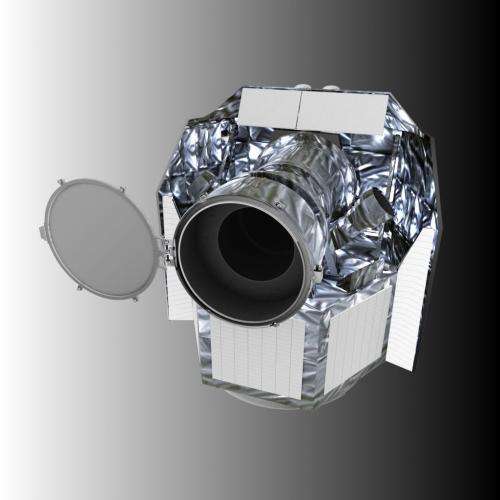Artist's impression of planet transiting a star. Credit: ESA/ATG medialab
ESA's first small Science Programme mission is ready for construction. The implementation phase has started, meaning that the spacecraft has gone from selection to implementation in less than 18 months.
The rapid progress places the CHaracterising ExOPlanet Satellite (CHEOPS) on course for meeting its target of being ready to launch by December 2017.
CHEOPS is the first in a possible class of small missions to be developed as part of ESA's Science Programme. These will be fast turn-around, highly focused missions that complement the Science Programme's medium and large missions.
CHEOPS will target nearby bright stars that are already known to have exoplanets in orbit around them, in order to provide new insight into the characteristics of those planets.
Ground-based Doppler searches find planets by detecting wobbles in the central star. CHEOPS will provide complementary data by monitoring the parent stars for transits: the dip in starlight caused by a planet's silhouette as it crosses the line of sight.
With such information, astronomers can determine the radius of the planet. With the mass known from ground-based Doppler searches, these data will allow astronomers to estimate the planet's density, allowing rocky planets to be distinguished from gas giants or any other type of planet. CHEOPS is designed to be sensitive to planets ranging from a few times the size of the Earth up to the size of Neptune.
Artist's impression of CHEOPS. Credit: ESA - C. Carreau
CHEOPS was selected by ESA in October 2012 from 26 proposals that were submitted in response to the announcement of the small mission programme. It was officially adopted into the Science Programme in February this year. Capped to an ESA cost of €50 million, it is being developed in collaboration with the Swiss Space Office (SSO), a division of the Swiss State Secretariat for Education, Research and Innovation (SERI), and the University of Bern, Switzerland. The Swiss organisations lead the consortium of 11 ESA Member States contributing to the mission and represented in the CHEOPS Science Team. The spacecraft will be built by Airbus Defence and Space, Spain.
"The cost and schedule constraints associated with a small mission in the Science Programme mean that all platform components and systems have to be 'off-the-shelf' and qualified for use in space. The only new development is the scientific instrument, which has to fulfil specific requirements but even that relies on available technologies," says Nicola Rando, ESA Definition Phase Manager for CHEOPS.
The Principal Investigator for the science instrument is Professor Willy Benz from the University of Bern, Switzerland, who was also the lead author for the mission's original proposal.
"CHEOPS is a unique high-precision photometric observatory that can point nearly anywhere in the sky. It will be used to search for transits on bright stars already known to host planets," says Benz. "By knowing where to look and at what time, CHEOPS is the most efficient instrument to detect shallow transits. It will significantly increase the sample of exoplanets for which we know both mass and radius, providing new insights and constraints on formation models. It will also provide the best targets for subsequent spectroscopic studies by the next generation of ground- and space-based instruments."
Although the technology used for CHEOPS must be off-the-shelf, the way the mission has been developed is a brand new way of working for ESA.
"CHEOPS demonstrates an interesting adaptation capability of ESA and its Member States in implementing missions," says Frédéric Safa, ESA Head of Future Missions Office, where CHEOPS is being implemented. "So far, its fast track schedule has been met thanks to an efficient collaboration between industry, the instrument consortium, and the ESA teams."
ESA is the mission architect for CHEOPS, responsible for spacecraft development and launch, and for the interface with the science community during science operations in orbit.
"The Member States' relative contribution to the mission is significantly larger than for medium and large missions, and a tailored industrial procurement approach had to be developed for meeting small mission programmatic targets, while preserving a science-driven approach for the mission. The good relationship between the ESA and the Swiss teams enabled fast decisions when needed and definitely played an important role," says Safa.
CHEOPS will most likely be launched as a passenger on a Soyuz or Vega launcher from Kourou at the end of 2017.
Provided by European Space Agency

























